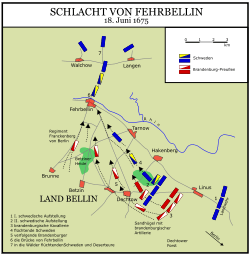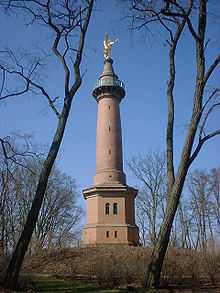Battle of Fehrbellin
| Battle of Fehrbellin | |||||||
|---|---|---|---|---|---|---|---|
| Part of the Scanian War (Northern Wars) Franco-Dutch War | |||||||
 19th century depiction | |||||||
| |||||||
| Belligerents | |||||||
|
|
| ||||||
| Commanders and leaders | |||||||
|
|
| ||||||
| Strength | |||||||
|
7,000–8,000 men, 14 cannon[1] |
7,000 men, 28 cannon[1] | ||||||
| Casualties and losses | |||||||
| 500–600 killed, wounded and captured[1] | 500–600 killed, wounded and captured[1] | ||||||
The Battle of Fehrbellin was fought on June 18, 1675 between Swedish and Brandenburg-Prussian troops. The Swedes, under Count Waldemar von Wrangel (stepbrother of Riksamiral Carl Gustaf Wrangel), had invaded and occupied parts of Brandenburg from their possessions in Pomerania, but were repelled by the forces of Frederick William, the Great Elector, under his Feldmarschall Georg von Derfflinger near the town of Fehrbellin. The battle went down in history as Prussia's baptism of fire.
Prelude
Prior to the battle the Swedes and Brandenburg had been allies in various wars against the Kingdom of Poland. However, when Elector Frederick William during the Franco-Dutch War had joined an allied expedition with Emperor Leopold I to Alsace against the forces of King Louis XIV of France, the French persuaded Sweden, which had been increasingly isolated on the continent, to attack Brandenburg while her army was away.
When Frederick William, encamping at Erstein, heard of the attack and occupation of a large part of his principality in December 1674, he immediately drew his army out of the coalition but had to take winter quarters at Marktbreit in Franconia. Leaving on 26 May 1675, he marched 250 kilometres (160 mi) to Magdeburg in only two weeks. This feat was considered one of the great marches in military history. He did it by abandoning his supply wagons and leaving large parts of the infantry behind, having his army buy supplies from the locals, but forbidding pillaging. The Swedes did not expect him to arrive that early.
Once he returned to Brandenburg, Frederick William realized that the Swedish forces, occupying the swampy Havelland region between Havelberg and the town of Brandenburg, were dispersed and ordered Derrflinger to take the central town of Rathenow in order to split them roughly down the middle. The elector bribed a local official loyal to him to hold a large and elaborate banquet for the Swedish officers of the fortress in order to get them drunk before the assault began in the night of June 14. Derfflinger then personally impersonated a Swedish officer and convinced the guards to open the gates of the town by claiming that a Brandenburg patrol was after him. Once the gates were opened for him, he led the charge of 1,000 dragoons against the city and the rest of the army soon followed. He was 69 years old at the time.
Once Derfflinger had expelled the Swedish garrison from Rathenow, this made the Swedish lines vulnerable. On June 17, the Brandenburgian troops reached Nauen. The Swedes, who had planned to cross the Elbe river in order to join forces with Brunswick troops, were forced back to their last position at Fehrbellin.
Battle
The Swedish commander, Wrangel, harassed by Brandenburg raiding parties under the command of Colonel Joachim Hennings, found himself hemmed in by a destroyed bridge over the Rhin river by the town of Fehrbellin. Impassable marshes on both flanks left Wrangel little choice but to give battle south of the nearby village of Hakenberg while his engineers repaired the span.

A total of 15,000 Brandenburgers,[2] including 5,600 cavalry and 13 cannons, faced 7,000 infantry, 4,000 cavalry and 38 guns on the Swedish side. One authority gives the Swedes a total of 12,000 troops.[3] Wrangel omitted to secure the surrounding heights, and Frederick William and Derfflinger, by placing their guns on a series of low hills to his left while the Swedes had only swamps to their flanks and a river behind them, gained a decisive tactical advantage.
These guns opened fire around noon on the 18th and caused heavy casualties on the Swedish right flank. Wrangel, now aware of the threat, attempted several times to wrest control of the hills but was stopped each time. Frederick William had his main attack press the right flank of the Swedes, eventually causing their cavalry to flee, and exposing their infantry to a flank attack led by Prince Frederick II of Hesse-Homburg. In several hours of close combat involving heavy losses, the Brandenburgian cavalry turned and routed a regiment of Swedish infantry. The Swedish right however held up long enough though for the Fehrbellin bridge to be repaired and Wrangel was able to get a large portion of his army across before darkness fell. Frederick William rejected all his officers' suggestions to shell the town.
The Brandenburg troops lost about 500 men. Wrangel's forces, although routed, lost only about the same amount on the day of the battle, but lost much more in the coming days' retreat pursued by the Brandenburgers up to Wittstock. Raiding parties, desertion, starvation, and other factors reduced the retreating Swedish army to a fraction of what it once was.

Historical significance
Upon the Brandenburgian victory, the Holy Roman Empire and Denmark finally met their obligations and declared war on Sweden. While Frederick William's forces invaded Swedish Pomerania, the Swedes did not enter the margraviate again until the 1679 Peace of Saint-Germain-en-Laye, which—to the elector's great disappointment—largely restored the status quo ante bellum.
Although only of minor importance militarily, the victory had enormous psychological impact: the Swedes, long considered unbeatable, had been bested and Brandenburg alone had prevailed against Swedish and French power politics. Frederick William henceforth was known as the "Great Elector", and the army that he and Derfflinger had led to victory became the core of the future Prussian Army vital for the country's development as a European great power. Glorified in the course of rising German nationalism under the rule of the House of Hohenzollern in the 19th century, June 18th was a holiday that would be celebrated in Germany up until 1914.
Reception
The Battle of Fehrbellin is the setting of Heinrich von Kleist's drama The Prince of Homburg written in 1809-10. However, the story of the prince's subordination, later popularised by the Prussian king Frederick the Great, may be a legend.
An observation tower on the Hakenberg hill with a Victoria statue on top similar to the Berlin Victory Column commemorates the battle. It was erected from 1875 on the initiative of Crown Prince Frederick III and inaugurated on September 2 (Sedantag), 1879.
See also
- Wars and battles involving Prussia
- Swedish invasion of 1674/1675
Notes
References
Citino is the major source for this article.
- Citino, Robert M. The German Way of War: From the Thirty Years War to the Third Reich. University Press of Kansas. Lawrence, KS, 2005. ISBN 0-7006-1410-9
- Dupuy, R. E. & Dupuy, T. N. The Encyclopedia of Military History. New York: Harper & Row, 1977. ISBN 0-06-011139-9
- Eggenberger, David. An Encyclopedia of Battles. New York: Dover Publications, 1985. ISBN 0-486-24913-1